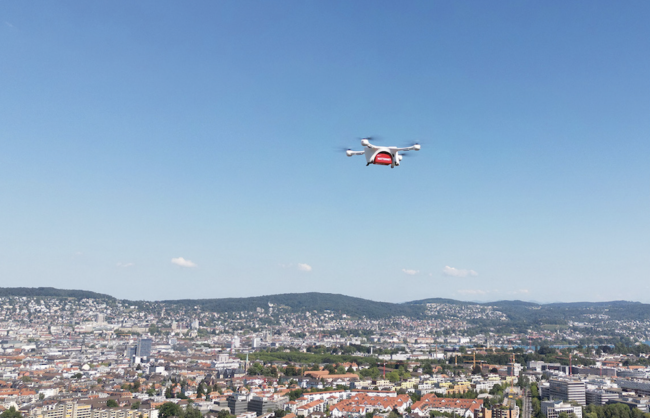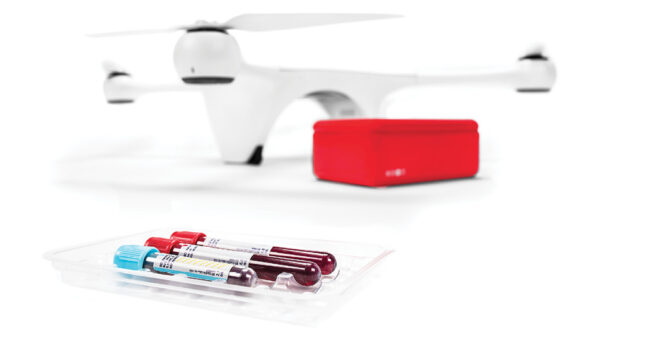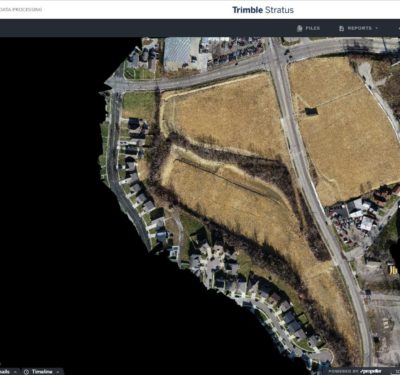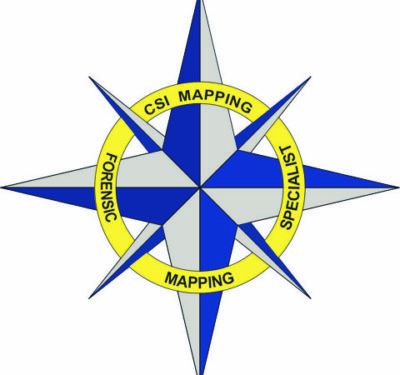The FAA is approving the design of some unmanned aircraft, which can help safely open the skies, but the process is lengthy and few companies have achieved it yet.

For four years, Matternet, a developer of drone delivery systems, had been deploying its unmanned aircraft over people and highways by seeking exemptions from the FAA. But since it received type certification for its M2 drone last September, the company can now fly the aircraft over urban areas without special permission.
That is a key advantage for the first non-defense company to receive type certification after a four-year evaluation by the FAA. Matternet, based in Mountainview, California, now hopes to scale its drone delivery of medicines and vaccines for hospital systems and consumers across the United States.

“The FAA is the gold standard for aviation safety in the world,” said Andreas Raptopoulos, founder and CEO of Matternet. “And they have defined that type certification is the process that aircraft manufacturers need to go through to be able to scale drone delivery in the U.S.”
Since the FAA began offering type certification for unmanned aerial systems in 2020, drone companies have been lining up to receive the designation. Yet the extensive process involved has slowed the number of companies that have been granted design approval of their unmanned aircraft.
“The FAA recognizes that this is really a burden on industry,” said Richard Thurau, an affiliate professor of the Metropolitan State University of Denver’s Aviation and Aerospace Science Department. “The innovation of UAS is such that if the FAA weren’t involved, there would be a lot more things happening and a lot more industry in the National Airspace that the certification process is overwatching. But the goal of the FAA really is safety.”

NEW RULES
The FAA began accepting applications for type certification for several classes of UAS in February of 2020. Type certification was defined as approval that “the design meets the safety expectations documented in the certification process,” according to the FAA.
The FAA viewed the new certification process as a step toward increasing confidence, both among the public and regulators, in the continuing advancement of drone technology. The certification process would also enable more complex operations beyond what the FAA allows under the small unmanned aircraft rule (Part 107), which includes package delivery, according to the FAA.
Within six months of announcing the type certification process for UAS, the FAA had received applications from 10 companies seeking the designation. Among them was Amazon, which is seeking certification of its Model MK27 unmanned aircraft for delivering packages. The proposal, still under FAA review, calls for the drone to operate BVLOS of the pilot and over people.
Because type certificate is considered a design approval, the FAA has required separate approval for specific operations, such as companies seeking to operate drones BVLOS.
“In the ruling about the type certification, the FAA was very explicit about saying that the type certification is really about the aircraft,” Thurau said. “It has to do with the aircraft, the motor and the actual mechanism for moving the aircraft through the air, or the propeller.”
SEEKING CERTIFICATION
For drone companies seeking certification, not only does the design of the aircraft need to be approved by the FAA, but so do all of its component parts.
Volz Servos, a German company, produces electromechanical actuators, or electric motors with gear trains that move the control surfaces of a vehicle. The company is currently working with a manufacturer that is participating in NASA’s Advanced Air Mobility (AAM) campaign, aimed at integrating air taxis, cargo delivery aircraft and other vehicles into the U.S. National Airspace System.
Because of its involvement in the NASA AAM campaign, Volz Servos needed to help the drone manufacturer achieve certification for the actuators that will be used in producing the airframe. The AAM project Volz Servos is working on involves creating an urban air taxi that will transport people from an airport to a downtown area in a city in the United States.
“If the actuator goes into a certified vehicle, then the design and the qualification—everything—is part of the vehicle’s certification,” said Mark Juhrig, the chief technical officer at Volz Servos. “The company that develops the vehicle is just receiving certification evidences from the actuator design organization, and then they present that material to their certification body.”
The two-year process includes producing test reports and design review materials that demonstrate the components comply with FAA standards. The air taxi, which will initially rely on a pilot before it transitions into an unmanned vehicle, would be certified under FAA’s Part 23, designed for small aircraft up to 6,000 pounds.
In a separate project, Volz Servos is also producing the actuators for a European company that is developing a 150-kilogram UAS that will be used for surveillance. The company developing the UAS must seek certification from the European Union Aviation Safety Agency (EASA) in a similar process that the FAA uses.
“It’s exactly the same process as for the urban air mobility project,” Juhrig said. “It’s just that it’s not transporting people, it’s transporting sensors.”
As with the FAA, companies seeking type certification from EASA must follow a series of guidelines designed for unmanned aircraft. “The general requirements to safety and the material you have to produce are about the same,” Juhrig said. “So, whether you do a certification with EASA or the FAA, it’s very similar from a workload point of view.”
If the airframe manufacturer receives certification, Volz Servos will become the first actuator company to work with a company that has received type certification for small aerial vehicles. Volz Servos is now halfway through the certification for both of its projects.
“If we are able to produce and develop actuators for these projects and demonstrate that we have the capability to do so, this is a real unique kind of thing,” Juhrig said. “There aren’t many actuator companies that can support this whole certification process and produce the evidences and documents that are required to support a certified airframe.”
RECEIVING TYPE CERTIFICATION
Matternet sees drones as the solution to the challenges of last-mile delivery, which is now dominated by trucks that take too much time to reach the consumer and are expensive and harmful to the environment, Raptopoulos said. He noted about 80% of the delivery market is located in urban and suburban areas.
To deploy a drone for delivery services in the United States, companies must have a 135 operational certificate and a type-certified aircraft. If the aircraft has not received type certification, then the company operating it must seek an exemption.
With its M2 drone now certified, Matternet can now expand its drone delivery business without an exemption. “This enables a different level of scale,” Raptopoulos said. “This aircraft can be produced in much larger quantities for operations in the U.S.”
While its type certification allows the M2 to deploy over people and highways, it is still not authorized to fly BVLOS. Raptopoulos said the company has received exemptions from the FAA to operate in an extended visual line of sight, which in Florida allows a delivery route of about three miles.
To expand its delivery options, Matternet is working with the FAA to authorize routes that are beyond the sight of land-based observers. “We believe that type certification is helping with that because the FAA knows us, they know our system, and it’s type certified to safety standards so it can be trusted,” Raptopoulos said.
Matternet has partnered with UPS on two projects deploying its M2 drone: delivering medical supplies for Atrium Health Wake Forest Baptist, a health care network in North Carolina, and bringing drugs from a CVS pharmacy to customers in the Villages, a retirement community in Florida.
With its type certification, the company plans to continue specializing in the health care arena, and hopes to expand operations with a new transportation company, Ameriflight, the largest cargo Part 135 airline in the country.
One potential focus for future projects will be creating citywide networks that rely on drone delivery. In a large city like Los Angeles, Raptopoulos envisions drone delivery connecting all the health care
facilities to one another with drone delivery and to key suppliers from labs, pharmacies and medical devices.
“Because health care wants to be close to people, health care systems in the U.S. and abroad are spread throughout cities,” he said. “And that creates a massive logistics challenge for them which we can solve with this type of system.”
Matternet also hopes to expand into home delivery for health care and other products, replacing trucks that now serve residential customers.
“We believe that in the next few years we’re going to see drone delivery becoming the infrastructure of cities and it’s going to change how delivery works,” Raptopoulos said. “We’d like to see that future where drone delivery’s utility is in every city.”
WEIGHING THE ADVANTAGES
Although achieving type certification can take four or five years, drone developers see significant advantages in pursuing this regulatory standard. Yet other companies have decided they do not want to invest the time in applying for type certification.
Fortem Technologies, which produces the DroneHunter F700, a counter-UAS weapon that is itself a drone, has decided not to seek type certification because its unmanned vehicles operate under Part 107, the FAA’s small UAS rule.
“We’re flying within visual line of sight,” said Greer Carper, the chief financial officer for Fortem. “When DroneHunter is deployed, there is someone on the ground who is watching and monitoring it accordingly.”
The DroneHunter is also used by federal law enforcement agencies, but they are exempt from needing type certification to deploy the aircraft, Carper said.
Type certification, nevertheless, is a definite advantage to drone companies because of the increased marketing potential for UAS that receive the designation. Thurau said he hopes the FAA will evaluate the certification and develop a more streamlined process that doesn’t take years for drone companies to complete.
“The payoff is huge but there are many benefits to a more rapid process for industry to more quickly integrate into the National Airspace,” he said. “I think what we’ll see as the years go by is they’re going to take the lessons learned from the type certification and speed up the process and start really making some smart connections with easing the burden on both the regulators and the industry.”
Another benefit from receiving type certification from the FAA is it can help drone companies seeking approval for UAS from EASA and agencies in other countries, Raptopoulos said.
“EASA has a different certificate but there are ways to get the FAA type certificate recognized by EASA and by other authorities around the world,” he said.
Type certification is “a massive advantage,” Raptopoulos said, because the air worthiness criteria that the FAA uses are strict. ‘The fact that our aircraft has been deemed to be safe and reliable and able to fly over people is a massive accomplishment, and something that we believe will drive the growth of our company in the United States and globally.”
Once the FAA starts granting type certification to more companies, the number of firms offering drone deliveries in urban areas will increase. Until that happens, the lack of approval for drone companies to operate in urban areas is hindering innovation in the industry, Thurau said.
“There are some amazingly creative people out there, particularly in the UAS world,” he said. “To get this type certification is really getting in at the ground-level, and the way that the FAA has rolled out its UAS regulations is that people who get in at this level, not only are they going to receive this certification, but the things that they want to do in the future—they’re already going to have the ear of the FAA so they’re going to have an innovative edge as well.”
All photos courtesy of Matternet.






